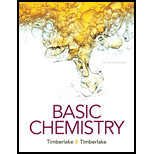
(a)
Interpretation:
The maximum number of electrons in the given orbitals needs to be determined.
Concept Introduction:
An atom consists of three sub-particles electrons, protons and neutrons. Out of these three protons and neutrons are placed at the centre of atom called as nucleus. Whereas electrons are placed in certain energy levels called as shell.
A sublevel in orbital can maximum hold two electrons with opposite spins.
(b)
Interpretation:
The maximum number of electrons in the given sublevel needs to be determined.
Concept Introduction:
An atom consists of three sub-particles electrons, protons and neutrons. Out of these three protons and neutrons are placed at the centre of atom called as nucleus. Whereas electrons are placed in certain energy levels called as shell.
A sublevel in orbital can maximum hold two electrons with opposite spins.
(c)
Interpretation:
The maximum number of electrons in the given energy level needs to be determined.
Concept Introduction:
An atom consists of three sub-particles electrons, protons and neutrons. Out of these three protons and neutrons are placed at the centre of atom called as nucleus. Whereas electrons are placed in certain energy levels called as shell.
A sublevel in orbital can maximum hold two electrons with opposite spins.
(d)
Interpretation:
The maximum number of electrons in the given sublevel needs to be determined.
Concept Introduction:
An atom consists of three sub-particles electrons, protons and neutrons. Out of these three protons and neutrons are placed at the centre of atom called as nucleus. Whereas electrons are placed in certain energy levels called as shell.
A sublevel in orbital can maximum hold two electrons with opposite spins.
Want to see the full answer?
Check out a sample textbook solution
Chapter 5 Solutions
Basic Chemistry (5th Edition)
 ChemistryChemistryISBN:9781305957404Author:Steven S. Zumdahl, Susan A. Zumdahl, Donald J. DeCostePublisher:Cengage Learning
ChemistryChemistryISBN:9781305957404Author:Steven S. Zumdahl, Susan A. Zumdahl, Donald J. DeCostePublisher:Cengage Learning ChemistryChemistryISBN:9781259911156Author:Raymond Chang Dr., Jason Overby ProfessorPublisher:McGraw-Hill Education
ChemistryChemistryISBN:9781259911156Author:Raymond Chang Dr., Jason Overby ProfessorPublisher:McGraw-Hill Education Principles of Instrumental AnalysisChemistryISBN:9781305577213Author:Douglas A. Skoog, F. James Holler, Stanley R. CrouchPublisher:Cengage Learning
Principles of Instrumental AnalysisChemistryISBN:9781305577213Author:Douglas A. Skoog, F. James Holler, Stanley R. CrouchPublisher:Cengage Learning Organic ChemistryChemistryISBN:9780078021558Author:Janice Gorzynski Smith Dr.Publisher:McGraw-Hill Education
Organic ChemistryChemistryISBN:9780078021558Author:Janice Gorzynski Smith Dr.Publisher:McGraw-Hill Education Chemistry: Principles and ReactionsChemistryISBN:9781305079373Author:William L. Masterton, Cecile N. HurleyPublisher:Cengage Learning
Chemistry: Principles and ReactionsChemistryISBN:9781305079373Author:William L. Masterton, Cecile N. HurleyPublisher:Cengage Learning Elementary Principles of Chemical Processes, Bind...ChemistryISBN:9781118431221Author:Richard M. Felder, Ronald W. Rousseau, Lisa G. BullardPublisher:WILEY
Elementary Principles of Chemical Processes, Bind...ChemistryISBN:9781118431221Author:Richard M. Felder, Ronald W. Rousseau, Lisa G. BullardPublisher:WILEY





